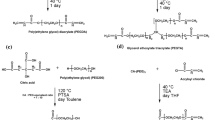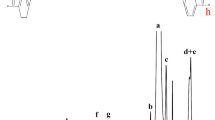Abstract
A series of thermosensitive polyethylene glycol (PEG)-polylactic-acid (PLA)-based hydrogels were synthesized, through the Diels–Alder reaction, with tunable hydrophilicity and hydrophobicity. Polyethylene glycol (PEG) was end-functionalized with furan groups using a synthetic furanic diol prepared by thiol-ene reaction. Functional maleimide PLA was prepared from PLA-diol, glycerol, 4,4′-methylenebis(cyclohexyl isocyanate) (H12MDI) and N-hydroxymethylmaleimide (HMM), by the isocyanate-alcohol condensation reaction. FTIR, 1H NMR, DSC, and SEC studies of the prepared precursors were carried out. Then, an organic solvent-free environmentally friendly synthesis was used to obtain the cross-linked Diels–Alder adducts, by changing the feeding ratio of PEG/PLA. The rheological studies proved the success of using Diels–Alder reaction, confirming the formation of cross-linked networks and its thermal dependence. After proceeding with their characterizations, the obtained adducts were brought into contact with the water leading to the formation of hydrogels. Swelling measurements revealed that the chemical composition influenced the swelling and the water diffusion mechanism of hydrogels. Finally, we found that hydrolytic degradation was governed by ester bond hydrolysis that could be controlled by adjusting the composition ratio of PEG to PLA.













Similar content being viewed by others
References
Chang H, Li C, Huang R, Su R, Qi W, He Z (2019) Amphiphilic hydrogels for biomedical applications. J Mater Chem B 7:2899–2910. https://doi.org/10.1039/C9TB00073A
Gao Y, Deng A, Wu X, Sun C, Qi C (2021) Injectable multi-responsive hydrogels cross-linked by responsive macromolecular micelles. React Funct Polym 161:104866. https://doi.org/10.1016/j.reactfunctpolym
Farhat W, Venditti R, Mignard N, Taha M, Becquart F, Ayoub A (2017) Polysaccharides and lignin based hydrogels with potential pharmaceutical use as a drug delivery system produced by a reactive extrusion process. Int J Biol Macromol 104:564–575. https://doi.org/10.1016/j.ijbiomac.2017.06.037
Ullah F, Othman MBH, Javed F, Ahmad Z, Akil HM (2015) Classification, processing and application of hydrogels: a review. Mater Sci Eng: C Mater Biol Appl 57:414–433. https://doi.org/10.1016/j.msec.2015.07.053
Ali A, Ahmed S (2018) Recent advances in edible polymer based hydrogels as a sustainable alternative to conventional polymers. J Agric Food Chem 66:6940–6967. https://doi.org/10.1021/acs.jafc.8b01052
Madduma-Bandarage USK, Madihally SV (2020) Synthetic hydrogels: synthesis, novel trends, and applications. J Appl Polym Sci 138:50376. https://doi.org/10.1002/app.50376
Francisco AT, Hwang PY, Jeong CG, Jing L, Chen J, Setton LA (2014) Photocrosslinkable laminin-functionalized polyethylene glycol hydrogel for intervertebral disc regeneration. Acta Biomater 10:1102–1111. https://doi.org/10.1016/j.actbio.2013.11.013
Nguyen MK, Alsberg E (2014) Bioactive factor delivery strategies from engineered polymer hydrogels for therapeutic medicine. Prog Polym Sci 39:1235–1265. https://doi.org/10.1016/j.progpolymsci.2013.12.001
Bakaic E, Smeets NMB, Hoare T (2015) Injectable hydrogels based on poly(ethylene glycol) and derivatives as functional biomaterials. RSC Adv 5:35469–35486. https://doi.org/10.1039/C4RA13581D
Vashist A, Vashist A, Gupta YK, Ahmad S (2014) Recent advances in hydrogel based drug delivery systems for the human body. J Mater Chem B 2:147–166. https://doi.org/10.1039/C3TB21016B
James R, Manoukian OS, Kumbar SG (2016) Poly(lactic acid) for delivery of bioactive macromolecules. Adv Drug Deliv Rev 107:277–288. https://doi.org/10.1016/j.addr.2016.06.009
Li L, Cao ZQ, Bao RY, Xie BH, Yang MB, Yang W (2017) Poly(L-lactic acid)-polyethylene glycol-poly(L-lactic acid) triblock copolymer: a novel macromolecular plasticizer to enhance the crystallization of poly(L-lactic acid). Eur Polym J 97:272–281. https://doi.org/10.1016/j.eurpolymj.2017.10.025
Metters AT, Anseth KS, Bowman CN (2000) Fundamental studies of a novel, biodegradable PEG-b-PLA hydrogel. Polymer 41:3993–4004. https://doi.org/10.1016/S0032-3861(99)00629-1
Mondal S, Das S, Nandi AK (2020) A review on recent advances in polymer and peptide hydrogels. Soft Matter 16:1404–1454. https://doi.org/10.1039/C9SM02127B
Buwalda SJ, Vermonden T, Hennink WE (2017) Hydrogels for therapeutic delivery: current developments and future directions. Biomacromol 18:316–330. https://doi.org/10.1021/acs.biomac.6b01604
Yu F, Cao X, Li Y, Zeng L, Yuan B, Chen X (2014) An injectable hyaluronic acid/PEG hydrogel for cartilage tissue engineering formed by integrating enzymatic crosslinking and Diels-Alder “click chemistry.” Polym Chem 5:1082–1090. https://doi.org/10.1039/C3PY00869J
Guaresti O, Garcia-Astrain C, Palomares T, Alonso-Varona A, Eceiza A, Gabilondo N (2017) Synthesis and characterization of a biocompatible chitosan- based hydrogel cross-linked via ‘click’ chemistry for controlled drug release. Int J Biolog Macromo 102:1–9. https://doi.org/10.1016/j.ijbiomac.2017.04.003
Gregoritza M, Brandl FP (2015) The Diels-Alder reaction: a powerful tool for the design of drug delivery systems and biomaterials. Eur J Pharm Biopharm Part B 97:438–453. https://doi.org/10.1016/j.ejpb.2015.06.007
Gandini A (2013) The furan/maleimide Diels-Alder reaction: a versatile click-unclick tool in macromolecular synthesis. Prog Polym Sci 38:1–29. https://doi.org/10.1016/j.progpolymsci.2012.04.002
Gheneim R, Perez-Berumen C, Gandini A (2002) Diels-Alder reactions with novel polymeric dienes and dienophiles: synthesis of reversibly cross-linked elastomers. Macromolecules 35:7246–7253. https://doi.org/10.1021/ma020343c
Gandini A, Carvalho AJF, Trovatti E, Kramer RK, Lacerda TM (2018) Macromolecular materials based on the application of the Diels-Alder reaction to natural polymers and plant oils. Eur J Lipid Sci Technol 120:1700091. https://doi.org/10.1002/ejlt.201700091
Tawney P, Synder R, Conger R, Leibbrand K, Stiteler C, Williams A (1961) The chemistry of maleimide and its derivatives. II. Maleimide and N-methylolmaleimide J Org Chem 26:15–21. https://doi.org/10.1021/jo01060a004
Djidi D, Mignard N, Taha M (2015) Thermosensitive polylactic-acid-based networks. Ind Crop. Prod 72:220–230. https://doi.org/10.1016/j.indcrop.2014.09.035
Mhiri S, Mignard N, Abid M, Prochazka F, Majeste JC, Taha M (2017) Thermally reversible and biodegradable polyglycolic-acid-based networks. Eur Polym J 88:292–310. https://doi.org/10.1016/j.eurpolymj.2017.01.020
Panwiriyarat W, Tanrattanakul V, Chueangchayaphan N (2017) Study on physicochemical properties of poly(ester-urethane) derived from biodegradable poly(ε-caprolactone) and poly(butylene succinate) as soft segments. Polym Bull 74:2245–2261. https://doi.org/10.1007/s00289-016-1833-x
Seidler K, Ehrmann K, Steinbauer P, Rohatschek A, Andriotis OG, Dworak C, Koch T, Bergmeister H, Grasl C, Schima H, Thurner PJ, Liska R, Baudis S (2018) A structural reconsideration: linear aliphatic or alicyclic hard segments for biodegradable thermoplastic polyurethanes? J Polym Sci Part A: Polym Chem 56:2214–2224. https://doi.org/10.1002/pola.29190
Gaina C, Ursache O, Gaina V, Varganici CD (2013) Thermally reversible cross-linked poly(ether-urethane)s. eXPRESS Polym Lett 7:636–650. https://doi.org/10.3144/expresspolymlett.2013.60
Li X, Becquart F, Taha M, Majeste JC, Chen J, Zhang S, Mignard N (2020) Tuning the thermoreversible temperature domain of PTMC-based networks with thermosensitive links concentration. Soft Matter 16:2815–2828. https://doi.org/10.1039/C9SM01882D
Zhang C (2006) Elastic degradable polyurethane for biomedical applications. ProQuest.
Duval A, Couture G, Caillol S, Avérous L (2017) Biobased and aromatic reversible thermoset networks from condensed tannins via the Diels-Alder reaction. ACS sustainable Chem Eng 5:1199–1207. https://doi.org/10.1021/acssuschemeng.6b02596
Gupta NV, Shivakumar HG (2012) Investigation of swelling behavior and mechanical properties of a pH-sensitive superporous hydrogel composite. Iran J Pharm Res 11:481–493. https://doi.org/10.22037/IJPR.2012.1097
Kim B, Kristen LF, Peppas NA (2003) Dynamic swelling behavior of pH-sensitive anionic hydrogels used for protein delivery. J Appl Polym Sci 89:1606–1613. https://doi.org/10.1002/app.12337
Neogi P (1996) Diffusion in Polymer. Marcel Dekker, New York., pp 147–171
Panpinit S, Pongsomboon SA, Keawin T, Saengsuwan S (2020) Development of multicomponent interpenetrating polymer network (IPN) hydrogel films based on 2-hydroxyl methacrylate (HEMA), acrylamide (AM), polyvinyl alcohol (PVA) and chitosan (CS) with enhanced mechanical strengths, water swelling and antibacterial properties. React Funct Polym 156:104739. https://doi.org/10.1016/j.reactfunctpolym.2020.104739
Almdal K, Dyre J, Hvidt S, Kramer O (1993) Towards a phenomenological definition of the term ‘gel.’ Polym Gels Networks 1:5–7. https://doi.org/10.1016/0966-7822(93)90020-I
Martinez VS, Olalde B, Redondo DM, Braceras I, Morin F, Valero J, Castro B (2014) Degradable poly(ethylene glycol)-based hydrogels: synthesis, physico-chemical properties and in vitro characterization. J Bioactive Compatible Polym 29:270–283. https://doi.org/10.1177/0883911514528597
Farhat W, Venditti RA, Becquart F, Ayoub A, Majesté JC, Taha M, Mignard N (2019) Synthesis and characterization of thermoresponsive xylan networks by Diels-Alder reaction. ACS App Polym Mater 1:856–866. https://doi.org/10.1021/acsapm.9b00095
Strachota B, Morand A, Dybal J, Matĕjka L (2019) Control of Gelation and properties of reversible Diels-Alder networks: design of a self-healing network. Polymers 11:930. https://doi.org/10.3390/polym11060930
Chapelle C, Quienne B, Bonneaud C, David G, Caillol S (2020) Diels-Alder-Chitosan based dissociative covalent adaptable networks. carbohydr Polym 253:117222. https://doi.org/10.1016/j.carbpol.2020.117222
Winter HH (1987) Evolution of rheology during chemical gelation. Prog Colloid Polym Sci 75:104–110. https://doi.org/10.1007/BFb0109413
Matricardi P, Meo CD, Coviello T, Hennink WE, Alhaique F (2013) Interpenetrating polymer networks polysaccharide hydrogels for drug delivery and tissue engineering. Adv Drug Deliv Rev 65:1172–1187. https://doi.org/10.1016/j.addr.2013.04.002
Kharkar PM, Kiick KL, Kloxin AM (2013) Designing degradable hydrogels for orthogonal control of cell microenvironments. Chem Soc Rev 42:7335–7372. https://doi.org/10.1039/C3CS60040H
Tsuji H, Ikarashi K (2004) In vitro hydrolysis of poly(L-lactide) crystalline residues as extended-chain crystallites: III. Effects of pH and enzyme. Polym Degrad Stab 85:647–656. https://doi.org/10.1016/j.polymdegradstab.2004.03.004
Kirchhof S, Strasser A, Wittmann HJ, Messmann V, Hammer N, Goepferich AM, Brandl FP (2015) New insights into the cross-linking and degradation mechanism of Diels-Alder hydrogels. J Mater Chem B 3:449–457. https://doi.org/10.1039/C4TB01680G
He X, Zhang X, He J, Liu F (2018) Preparation and properties of hydroxyl-terminated cationic waterborne polyurethanes for cathodic electrodeposition coating. Adv Polym Technol 37:3831–3841. https://doi.org/10.1002/adv.22166
Opera S (2012) Degradation of crosslinked poly(ester-urethanes) elastomers in distilled water: influence of hard segment. J Appl Polym Sci 124:1059–1066. https://doi.org/10.1002/app.35196
Acknowledgements
The authors acknowledge the NMR Polymer Center of the Institut de Chimie de Lyon for assistance.
Funding
This work was financially supported by the Ministry of foreign affairs and international development in France for Eiffel Scholarship, Rhône Alpes for CMIRA scholarship and the Ministry of Higher Education, Scientific Research and Technology in Tunisia.
Author information
Authors and Affiliations
Corresponding author
Ethics declarations
Conflict of interest
The authors declare no competing interests.
Additional information
Publisher's Note
Springer Nature remains neutral with regard to jurisdictional claims in published maps and institutional affiliations.
Supplementary Information
Below is the link to the electronic supplementary material.
Rights and permissions
About this article
Cite this article
Mhiri, S., Abid, M., Abid, S. et al. Green synthesis of covalent hybrid hydrogels containing PEG/PLA-based thermoreversible networks. J Polym Res 29, 328 (2022). https://doi.org/10.1007/s10965-022-03153-9
Received:
Accepted:
Published:
DOI: https://doi.org/10.1007/s10965-022-03153-9




